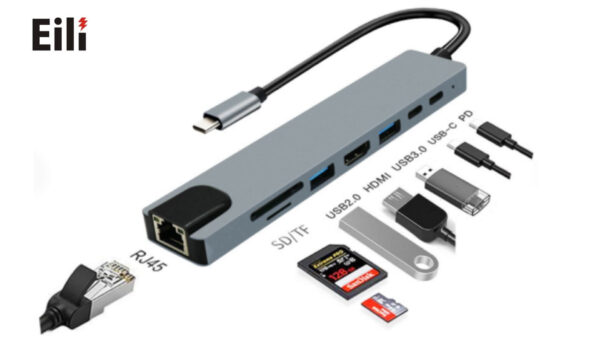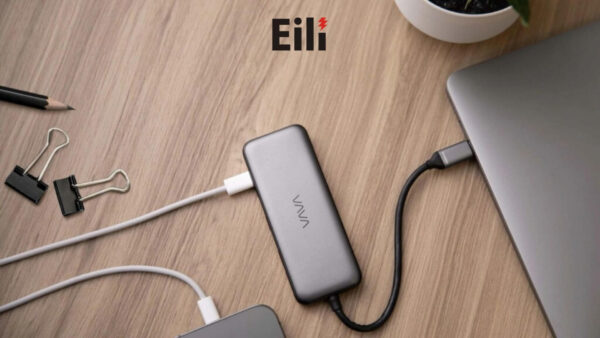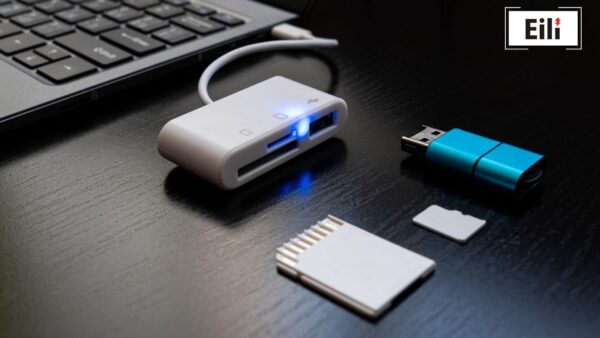USB Hubs
Quick Fixes for Common USB Hub Problems: Troubleshooting Tips
USB hubs are incredibly convenient devices that allow you to expand the number of USB ports on your computer, laptop, or other devices. They streamline connectivity and simplify the management of multiple peripherals, from keyboards and mice to external hard drives and printers. However, like any electronic device, USB hubs can encounter issues that hinder their functionality. In this article, Eili Industrial will help you to equip the knowledge and troubleshooting steps to resolve common USB hub problems, ensuring your devices remain seamlessly connected and operational.
Understanding USB Hubs and Their Functionality
Before delving into troubleshooting, it’s crucial to grasp the basics of how USB hubs work. A USB hub acts as a bridge, connecting multiple USB devices to a single USB port on your host device (computer, laptop, etc.). It essentially splits the available bandwidth of the host port amongst the connected peripherals. Understanding this fundamental function will help in diagnosing issues more effectively.
Types of USB Hubs

USB hubs come in various forms, each with specific capabilities and features:
Powered Hubs: These hubs require an external power source (typically via a wall adapter) to provide sufficient power to multiple connected devices, especially those that require high power consumption (e.g., external hard drives).
Unpowered/Passive Hubs: These hubs draw power directly from the host port and are suitable for connecting low-power devices such as keyboards, mice, and flash drives. They often have limited port capacity and may not be able to power demanding peripherals.
Data Transfer Speed: USB hubs support different data transfer speeds, with USB 3.0 and USB-C hubs offering significantly faster speeds compared to USB 2.0.
Connectivity: They can be connected via various interfaces, including USB-A, USB-C, and even Thunderbolt ports.
Understanding these differences is key when selecting a hub that meets your needs. Now let’s take a closer look at the common issues users face with USB hubs and explore effective troubleshooting techniques to overcome them.
Common USB Hub Issues and Their Solutions
Now, let’s dive into the most prevalent issues encountered with USB hubs and explore effective troubleshooting techniques to overcome them. Each issue can stem from multiple causes, and understanding these factors will enable you to tackle the problem systematically.
Devices Not Recognized or Connected
One of the most frustrating experiences is when devices connected to your USB hub are not recognized by your host machine. This could stem from several underlying causes, which we will explore below.
Possible Causes
Faulty USB Hub: The hub itself might be malfunctioning due to physical damage or internal components failure.
Insufficient Power: For powered hubs, a faulty power supply or insufficient power can lead to devices not being recognized. Unpowered hubs may not provide enough power for multiple devices, especially those with high power demands.
Driver Issues: Outdated or incompatible drivers for the hub or connected devices might prevent proper communication.
Port Issues: The USB port on the host device or the hub might be damaged or malfunctioning.
Cable Issues: A damaged or faulty USB cable connecting the hub to the host device can disrupt the connection.
Troubleshooting Steps
To address the issue where your connected devices are not recognized, start by checking all connections. Ensure that all cables are securely connected to both the hub and the host device, as well as to the individual peripherals. Sometimes, it’s simply a matter of a loose connection causing the issue. If everything appears connected, try using different USB ports on both the hub and the host device.
Another effective method is to perform a power cycle on the USB hub. Disconnect the hub from its power source (if applicable) and the host device, wait for a few seconds, and then reconnect them. This action often resolves temporary glitches. Additionally, testing the hub with different devices can help determine if the issue lies with the hub or the peripherals themselves.
Slow Data Transfer Speeds
If you’re experiencing slow data transfer speeds when using the hub, it might indicate a bottleneck in the connection. This can be particularly frustrating if you rely on fast data transfer for tasks such as backing up files or transferring large media.
Possible Causes
USB Hub Version: A USB 2.0 hub connected to a USB 3.0 port will limit the data transfer speed to the slower USB 2.0 standard.
Overloaded Hub: Connecting too many devices to a hub can significantly reduce individual device speeds.
Faulty USB Cable: A damaged or incompatible USB cable can significantly reduce data transfer rates.
Driver Issues: Outdated or corrupted drivers can interfere with fast data transfer.
Interference: Electromagnetic interference from other devices can affect data transfer speeds.
Troubleshooting Steps

To tackle the problem of slow data transfer speeds, first check the USB version of your hub and connected devices. Ensure that both your hub and cables support the desired data transfer speeds (such as USB 3.0 or 3.1). If your hub is a legacy model, consider upgrading to a more recent version to leverage faster data rates.
Reducing the load on the hub can also lead to better performance. Disconnecting some devices may improve the overall speed. Additionally, replacing the USB cable with a high-quality, certified one can make a noticeable difference in transfer rates. Always remember to keep your drivers updated to ensure optimal performance.
Devices Disconnecting Intermittently
The annoyance of devices unexpectedly disconnecting and reconnecting can disrupt productivity and lead to data loss. Understanding the cause behind this issue is crucial for a long-term fix.
Possible Causes
Insufficient Power: Similar to the ‘Devices Not Recognized’ issue, a lack of adequate power from the hub can cause intermittent disconnections, especially when demanding peripherals are connected.
Overloaded Hub: Too many devices pulling power simultaneously can overwhelm the hub, leading to intermittent disconnections.
Driver Issues: Conflicting or corrupted drivers can cause instability and intermittent disconnections.
Faulty USB Port/Cable: A damaged USB port on the hub or the host device, or a faulty USB cable connecting them, can result in unstable connections.
Electromagnetic Interference: Interference from other electronic devices can disrupt the USB connection.
Troubleshooting Steps
To address intermittent disconnection issues, start by reducing the load on your USB hub. Disconnecting some of the connected devices may stabilize the connection. Furthermore, check the power supply if you are using a powered hub. If you suspect that your current power adapter is inadequate, consider using a higher-wattage power adapter if necessary.
Updating drivers can also play a significant role in resolving stability issues. Once you’ve performed these checks, try relocating the hub away from potential sources of electromagnetic interference, which can also contribute to connectivity problems.
USB Hub Overheating
Overheating can pose serious risks to your USB hub, potentially leading to hardware damage. It’s essential to monitor temperature levels and understand the underlying causes of overheating.
Possible Causes
Insufficient Ventilation: Inadequate airflow around the hub can cause it to overheat.
Overloaded Hub: Too many power-hungry devices connected to the hub can generate excessive heat.
Faulty Components: A damaged internal component within the hub could cause it to overheat.
Troubleshooting Steps
Improving ventilation is the most straightforward way to mitigate overheating. Ensure the area surrounding the hub allows for optimal airflow; avoid placing it in enclosed spaces or stacking other devices on top of it.
Reducing the load by disconnecting some devices can also help alleviate heat generation, allowing your hub to function smoothly. If your USB hub continues to overheat despite taking these measures, it may be time to consider investing in a newer model designed with better thermal management features.
USB Hub Not Working at All
If your USB hub is entirely unresponsive, it could be indicative of a more serious issue. This scenario can be perplexing and warrants thorough investigation.
Possible Causes
Physical Damage: The hub might have sustained physical damage due to drops, impacts, or liquid spills.
Internal Component Failure: A critical internal component might have failed due to age, wear, or power surges.
Power Supply Failure: For powered hubs, a faulty power supply can render it completely non-functional.
Troubleshooting Steps
Begin by inspecting the hub for any visible signs of physical damage, such as cracks or broken parts. If the hub has a power supply, verify that it is functioning correctly. Testing the hub with a different USB port on your host device can sometimes yield positive results as well.
If none of these methods prove successful, and if your hub includes a reset button, pressing it may restore functionality. However, if the issue persists, it is advisable to contact the manufacturer for repair or replacement options.
Preventing Future USB Hub Issues

By following a few simple preventative measures, you can significantly reduce the likelihood of encountering common USB hub issues. Keeping your setup organized and well-maintained can maximize performance and longevity.
Avoid Overloading
Don’t connect too many high-power devices to an unpowered or low-powered hub. Be mindful of how much power your peripherals consume, and distribute the load accordingly.
Use Quality Cables
Invest in high-quality, certified USB cables that are compatible with your hub and devices. Poor quality cables can introduce errors and connectivity issues.
Maintain Proper Ventilation
Keep the hub in a well-ventilated area to prevent overheating. Avoid enclosures or cramped spaces that restrict airflow.
Protect from Physical Damage
Handle the hub with care, avoiding exposure to extreme temperatures, moisture, or shocks that could compromise its integrity.
Update Drivers Regularly
Ensure the drivers for your hub and connected devices are up-to-date to maintain optimal performance and stability. Regular updates can preempt compatibility issues.
Conclusion
USB hubs remain an essential part of our digital lives, enabling us to connect multiple devices to our computers and other electronics. By understanding the common issues that can arise and adopting the troubleshooting steps outlined in this guide, you can keep your USB hubs functioning smoothly and ensure your peripherals remain reliably connected. Remember that preventative measures, such as avoiding overloading and ensuring proper ventilation, can significantly contribute to the longevity and effectiveness of your USB hub. With the right approach, you can enjoy a seamless connectivity experience with all your devices.
Related Articles:
Connect with Eili:


